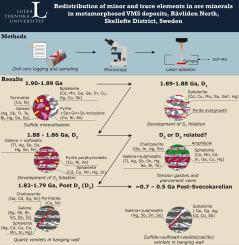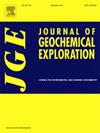Redistribution of minor and trace elements in ore minerals in metamorphosed VMS deposits, Rävliden North, Skellefte district, Sweden
IF 3.3
2区 地球科学
Q1 GEOCHEMISTRY & GEOPHYSICS
引用次数: 0
Abstract
The Rävliden North volcanogenic massive sulfide (VMS) deposit, in northern Sweden underwent polyphase deformation and greenschist to lower amphibolite facies metamorphism during the Svecokarelian orogeny. This caused remobilisation and recrystallisation of ore minerals, whose composition was analysed using laser ablation inductively coupled plasma mass spectrometry (LA-ICP-MS) and electron probe microanalysis (EPMA). Sphalerite, chalcopyrite, and pyrrhotite chemistry mirrors zonation of undeformed VMS deposits. Chalcopyrite-rich mineralisation contains higher Cu, Co, In, and lower Mn concentrations than sphalerite-rich mineralisation. Besides galena, Ag occurs in sulfosalts, tellurides, antimonides, and amalgams, which possibly formed through exsolutions from α-galena in syn- to post-tectonic structures. LA-ICP-MS imaging shows Ag-rich minerals in early syngenetic pyrite, in contrast to syn-metamorphic pyrite, indicating remobilisation during deformation. Despite sampling effects accounted for through linear mixed effects (LME) modelling, the results indicate that syn-metamorphic recrystallisation and remobilisation did not lead to substantial compositional changes in ore minerals. Instead, these processes partitioned Ga between sphalerite and chalcopyrite and enriched Ag, Cd, and Sb in minerals associated with younger parageneses. Zeolite-bearing veins in the hanging wall host sphalerite with the highest Ga, Ge, Cu, and Sb contents and galena with the lowest Bi, Te, and Tl contents. An origin potentially linked to far-field effects of the opening of the Iapetus Ocean or waning Timanian orogeny is discussed based on similarities to other vein- and breccia-hosted Zn![]() Pb deposits in Northern Sweden. This study provides the first multiple-mineral in-situ trace element dataset for a VMS deposit in the Skellefte district, enhances understanding of element redistribution during metamorphism, and identifies remobilised elements potentially vectoring mineralisation at depth. Moreover, this study enables tracing of penalty and by-product elements in downstream beneficiation processes.
Pb deposits in Northern Sweden. This study provides the first multiple-mineral in-situ trace element dataset for a VMS deposit in the Skellefte district, enhances understanding of element redistribution during metamorphism, and identifies remobilised elements potentially vectoring mineralisation at depth. Moreover, this study enables tracing of penalty and by-product elements in downstream beneficiation processes.

瑞典Skellefte地区Rävliden北变质VMS矿床矿石中微量元素的再分布
位于瑞典北部的Rävliden北火山块状硫化物(VMS)矿床在Svecokarelian造山运动中经历了多期变形和绿片岩-下角闪岩相变质作用。这导致矿石矿物的再活化和再结晶,其成分分析使用激光烧蚀电感耦合等离子体质谱(LA-ICP-MS)和电子探针微量分析(EPMA)。闪锌矿、黄铜矿和磁黄铁矿的化学性质反映了未变形VMS矿床的分带性。富黄铜矿矿化比富闪锌矿化含有较高的Cu、Co、In和较低的Mn浓度。除方铅矿外,银还存在于亚硫酸盐、碲化物、锑化物和银汞合金中,可能是α-方铅矿在同构造至后构造中析出形成的。LA-ICP-MS成像显示早期同生黄铁矿中富银矿物,与同变质黄铁矿形成对比,表明变形过程中再活化。尽管通过线性混合效应(LME)模型考虑了采样效应,但结果表明,同变质再结晶和再活化并未导致矿石矿物成分发生实质性变化。相反,这些过程在闪锌矿和黄铜矿之间分配了Ga,并在与较年轻的共生矿相关的矿物中富集了Ag、Cd和Sb。上壁面含沸石矿脉中含有Ga、Ge、Cu、Sb含量最高的闪锌矿和Bi、Te、Tl含量最低的方铅矿。根据与瑞典北部其他脉状和角砾岩型铅锌矿的相似之处,讨论了可能与Iapetus洋打开或土库曼斯坦造山运动减弱的远场影响有关的起源。该研究为Skellefte地区VMS矿床提供了首个多矿物原位微量元素数据集,增强了对变质过程中元素再分布的认识,并识别了可能在深度上引导矿化的再活动元素。此外,这项研究使下游选矿过程中的惩罚和副产品元素的追踪成为可能。
本文章由计算机程序翻译,如有差异,请以英文原文为准。
求助全文
约1分钟内获得全文
求助全文
来源期刊

Journal of Geochemical Exploration
地学-地球化学与地球物理
CiteScore
7.40
自引率
7.70%
发文量
148
审稿时长
8.1 months
期刊介绍:
Journal of Geochemical Exploration is mostly dedicated to publication of original studies in exploration and environmental geochemistry and related topics.
Contributions considered of prevalent interest for the journal include researches based on the application of innovative methods to:
define the genesis and the evolution of mineral deposits including transfer of elements in large-scale mineralized areas.
analyze complex systems at the boundaries between bio-geochemistry, metal transport and mineral accumulation.
evaluate effects of historical mining activities on the surface environment.
trace pollutant sources and define their fate and transport models in the near-surface and surface environments involving solid, fluid and aerial matrices.
assess and quantify natural and technogenic radioactivity in the environment.
determine geochemical anomalies and set baseline reference values using compositional data analysis, multivariate statistics and geo-spatial analysis.
assess the impacts of anthropogenic contamination on ecosystems and human health at local and regional scale to prioritize and classify risks through deterministic and stochastic approaches.
Papers dedicated to the presentation of newly developed methods in analytical geochemistry to be applied in the field or in laboratory are also within the topics of interest for the journal.
 求助内容:
求助内容: 应助结果提醒方式:
应助结果提醒方式:


